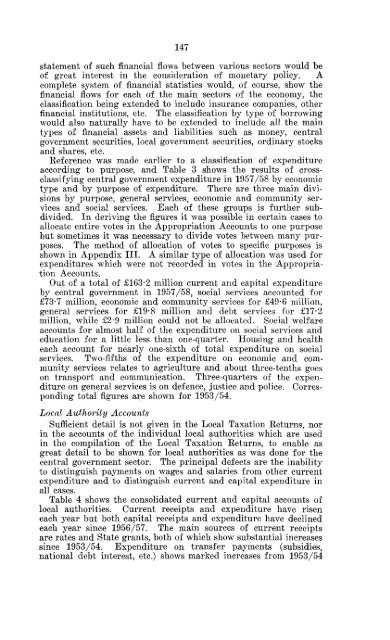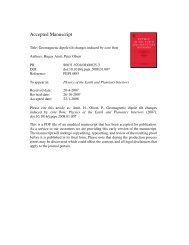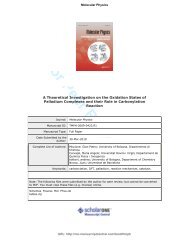An Analysis of Government Revenue and Expenditure in ... - TARA
An Analysis of Government Revenue and Expenditure in ... - TARA
An Analysis of Government Revenue and Expenditure in ... - TARA
Create successful ePaper yourself
Turn your PDF publications into a flip-book with our unique Google optimized e-Paper software.
147<br />
statement <strong>of</strong> such f<strong>in</strong>ancial flows between various sectors would be<br />
<strong>of</strong> great <strong>in</strong>terest <strong>in</strong> the consideration <strong>of</strong> monetary policy. A<br />
complete system <strong>of</strong> f<strong>in</strong>ancial statistics would, <strong>of</strong> course, show the<br />
f<strong>in</strong>ancial flows for each <strong>of</strong> the ma<strong>in</strong> sectors <strong>of</strong> the economy, the<br />
classification be<strong>in</strong>g extended to <strong>in</strong>clude <strong>in</strong>surance companies, other<br />
f<strong>in</strong>ancial <strong>in</strong>stitutions, etc. The classification by type <strong>of</strong> borrow<strong>in</strong>g<br />
would also naturally have to be extended to <strong>in</strong>clude all the ma<strong>in</strong><br />
types <strong>of</strong> f<strong>in</strong>ancial assets <strong>and</strong> liabilities such as money, central<br />
government securities, local government securities, ord<strong>in</strong>ary stocks<br />
<strong>and</strong> shares, etc.<br />
Reference was made earlier to a classification <strong>of</strong> expenditure<br />
accord<strong>in</strong>g to purpose, <strong>and</strong> Table 3 shows the results <strong>of</strong> crossclassify<strong>in</strong>g<br />
central government expenditure <strong>in</strong> 1957/58 by economic<br />
type <strong>and</strong> by purpose <strong>of</strong> expenditure. There are three ma<strong>in</strong> divisions<br />
by purpose, general services, economic <strong>and</strong> community services<br />
<strong>and</strong> social services. Each <strong>of</strong> these groups is further subdivided.<br />
In deriv<strong>in</strong>g the figures it was possible <strong>in</strong> certa<strong>in</strong> cases to<br />
allocate entire votes <strong>in</strong> the Appropriation Accounts to one purpose<br />
but sometimes it was necessary to divide votes between many purposes.<br />
The method <strong>of</strong> allocation <strong>of</strong> votes to specific purposes is<br />
shown <strong>in</strong> Appendix III. A similar type <strong>of</strong> allocation was used for<br />
expenditures which were not recorded <strong>in</strong> votes <strong>in</strong> the Appropriation<br />
Accounts.<br />
Out <strong>of</strong> a total <strong>of</strong> £163*2 million current <strong>and</strong> capital expenditure<br />
by central government <strong>in</strong> 1957/58, social services accounted for<br />
£73*7 million, economic <strong>and</strong> community services for £49*6 million,<br />
general services for £19*8 million <strong>and</strong> debt services for £17-2<br />
million, while £2-9 million could not be allocated. Social welfare<br />
accounts for almost half <strong>of</strong> the expenditure on social services <strong>and</strong><br />
education for a little less than one-quarter. Hous<strong>in</strong>g <strong>and</strong> health<br />
each account for nearly one-sixth <strong>of</strong> total expenditure on social<br />
services. Two-fifths <strong>of</strong> the expenditure on economic <strong>and</strong> community<br />
services relates to agriculture <strong>and</strong> about three-tenths goes<br />
on transport <strong>and</strong> communication. Three-quarters <strong>of</strong> the expenditure<br />
on general services is on defence, justice <strong>and</strong> police. Correspond<strong>in</strong>g<br />
total figures are shown for 1953/54.<br />
Local Authority Accounts<br />
Sufficient detail is not given <strong>in</strong> the Local Taxation Returns, nor<br />
<strong>in</strong> the accounts <strong>of</strong> the <strong>in</strong>dividual local authorities which are used<br />
<strong>in</strong> the compilation <strong>of</strong> the Local Taxation Returns, to enable as<br />
great detail to be shown for local authorities as was done for the<br />
central government sector. The pr<strong>in</strong>cipal defects are the <strong>in</strong>ability<br />
to dist<strong>in</strong>guish payments on wages <strong>and</strong> salaries from other current<br />
expenditure <strong>and</strong> to dist<strong>in</strong>guish current <strong>and</strong> capital expenditure <strong>in</strong><br />
all cases.<br />
Table 4 shows the consolidated current <strong>and</strong> capital accounts <strong>of</strong><br />
local authorities. Current receipts <strong>and</strong> expenditure have risen<br />
each year but both capital receipts <strong>and</strong> expenditure have decl<strong>in</strong>ed<br />
each year s<strong>in</strong>ce 1956/57. The ma<strong>in</strong> sources <strong>of</strong> current receipts<br />
are rates <strong>and</strong> State grants, both <strong>of</strong> which show substantial <strong>in</strong>creases<br />
s<strong>in</strong>ce 1953/54. <strong>Expenditure</strong> on transfer payments (subsidies,<br />
national debt <strong>in</strong>terest, etc.) shows marked <strong>in</strong>creases from 1953/54
















